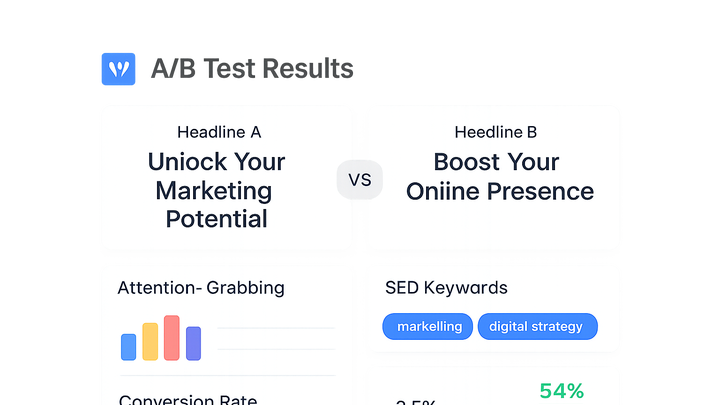Published on 2025-06-29T19:41:55Z
What is Headline Optimization? Examples and Best Practices
Headline optimization is the process of refining and testing your website’s headlines to maximize attention, clicks, and conversions. In the fields of Conversion Rate Optimization (CRO), User Experience (UX), and Search Engine Optimization (SEO), headlines serve as the first point of contact between your content and your audience. A compelling headline not only draws readers in but also helps search engines understand and rank your page. Effective headline optimization balances emotional appeal, clarity, and keyword relevance to boost engagement, improve organic rankings, and drive measurable business results.
Using tools like Prevue.me, marketers and UX designers can receive targeted critiques and data-driven suggestions to enhance headline performance, ensuring each word serves a strategic purpose. Whether you’re crafting a blog post, landing page, or ad headline, systematic optimization empowers you to iterate rapidly and discover what truly resonates with your audience.
By focusing on headline optimization, you can transform passive visitors into active participants, reduce bounce rates, and ultimately increase leads and sales. This glossary entry explores why headline optimization matters, outlines key strategies, and highlights essential tools to help you master the art of crafting headlines that convert.
Headline optimization
Refine and test your website's headlines to boost clicks, engagement, SEO rankings, and conversions.
Why Headline Optimization Matters
Optimizing headlines is crucial because it directly impacts user engagement, search rankings, and conversion rates. Headlines form the first impression, guiding users’ perception of your content and determining whether they stay or bounce. From an SEO perspective, well-crafted headlines help search engines understand page relevance and improve SERP visibility. From a UX standpoint, clear and scannable headings make content more approachable.
A strategic approach to headline optimization can:
- Increase click-through rates (CTR)
- Reduce bounce rates and improve time-on-page
- Enhance organic search performance
- Strengthen brand messaging and clarity
-
First impressions and user engagement
The headline is often the first element a visitor notices. A powerful headline captures attention, sets expectations, and encourages further reading. Poorly written or vague headlines can lead to confusion and immediate exits.
- Visual hierarchy:
Use size, color, and placement to make the headline stand out on the page.
- Readability and scanning:
Keep headlines concise and avoid jargon to ensure they’re easily skimmable.
- Visual hierarchy:
-
Seo and discoverability
Search engines use headlines (H1 tags) to understand page content. Including primary keywords in headlines can improve ranking potential and click-through on search results pages.
- Title tag relevance:
Align your H1 headline with the meta title tag for consistency and SEO benefit.
- Rich snippet potential:
Use descriptive headlines that can be featured in rich snippets and featured answers.
- Title tag relevance:
-
Conversion rate impact
Effective headlines guide users toward desired actions, whether it’s subscribing, purchasing, or signing up. They can make or break your conversion funnel.
- Click-through rate (ctr):
Measure how often users click your headline in both organic results and on-page links.
- Bounce rate reduction:
Engaging headlines encourage deeper exploration and reduce quick exits.
- Click-through rate (ctr):
Key Strategies for Optimizing Headlines
Implement a structured framework when crafting and refining headlines. Consider emotional impact, clarity, and keyword integration. Always back decisions with data from testing and analytics to ensure each headline resonates with your target audience.
-
Use power words and emotional triggers
Incorporate persuasive language that evokes curiosity, urgency, or specific emotions to increase engagement.
- Scarcity and urgency:
Words like ‘limited’, ‘now’, and ‘exclusive’ drive immediate action.
- Curiosity gap:
Pose questions or teasers that compel users to click for answers.
- Scarcity and urgency:
-
Incorporate keywords naturally
Balance SEO requirements with readability. Place primary keywords early in the headline without sacrificing clarity.
- Keyword placement:
Aim to include the main keyword within the first few words.
- Long-tail variations:
Use specific, descriptive phrases to capture niche search queries.
- Keyword placement:
-
A/b test variations and analyze data
Continuously experiment with headline versions to identify which phrasing or structure performs best across metrics like CTR and conversion rate.
- Hypothesis and metrics:
Define clear goals for each test, such as a 10% increase in CTR.
- Statistical significance:
Run tests long enough to reach reliable, data-driven conclusions.
- Iterative improvements:
Use learnings from one test to inform subsequent headline experiments.
- Hypothesis and metrics:
-
Align with ux and accessibility
Ensure headlines are perceivable and understandable for all users, including those with disabilities.
- Contrast and font readability:
Use high color contrast and legible font sizes to aid visibility.
- Screen reader compatibility:
Use proper heading tags (H1, H2) and clear wording for assistive technologies.
- Contrast and font readability:
Tools and Examples for Headline Optimization
A variety of tools can help you generate, test, and refine headlines. These range from specialized CRO platforms to SEO suites and AI-driven critique services. Here’s how prevue.me and other popular platforms support headline optimization:
-
Prevue.me
An AI-powered critique tool that evaluates headlines for CRO, lead generation, SEO, UX, and accessibility. Provides actionable feedback and scores headlines on multiple dimensions.
- Actionable cro insights:
Recommends specific changes to increase clicks and conversions.
- Seo-friendly headline scoring:
Analyzes keyword usage, length, and search intent alignment.
- Ux readability analysis:
Assesses readability, scannability, and visual hierarchy.
- Actionable cro insights:
-
A/b testing platforms
Tools like Optimizely and Google Optimize enable you to run experiments on headline variations to determine the highest-performing options.
- Set up experiments:
Define control and variant headlines within your page.
- Define variations:
Test different phrasing, lengths, and emotional appeals.
- Analyze results:
Review statistical reports to choose the winning headline.
- Set up experiments:
-
Seo analysis tools
Platforms such as SEMrush and Ahrefs allow you to research keyword effectiveness and preview how headlines will display in search results.
- Keyword gap analysis:
Identify missing opportunities based on competitor headlines.
- Headline serp ranking preview:
Visualize how your headline appears in search engine results.
- Keyword gap analysis:
